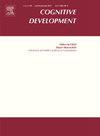How to juggle languages: Verbal short-term memory as a key predictor of code-switching in dual language learning 3- to 6-year-olds
IF 1.8
3区 心理学
Q3 PSYCHOLOGY, DEVELOPMENTAL
引用次数: 0
Abstract
This study investigates how dual language learning preschooler’s code-switching relates to their linguistic and cognitive strengths and challenges. Utilizing a cross-sectional approach, we examined preschool-aged children in Switzerland and Germany acquiring a societal language (German or French) together with a heritage language (Italian or Turkish). We hypothesized that age-related maturation in verbal short-term memory, alongside language abilities and inhibitory control, shapes children’s code-switching both within (intrasententially) and between sentences (intersententially). Parent-based code-switching reports of 106 children aged three to six years were incorporated into a generalized mixed model analysis, which also included data from linguistically parallelized tests administering societal and heritage language skills together with linguistically unbiased cognitive assessments. Findings indicate that as children age, their intrasentential switches to the heritage language decrease, while their intrasentential switches to the societal language slightly increase. Verbal short-term memory, improving with age, seems to facilitate intrasentential switching to the societal language. Moreover, strong inhibitory control helps avoid unintended intrasentential switches to the societal language. Switching intersententially is not affected by age or cognition. Irrespective of intra- or intersentential switches, switching towards the societal and heritage language reflects children’s linguistic strengths and difficulties, with a noticeable preference for switching into the societal majority language, even when language proficiencies are controlled. Using a comprehensive research design, this study offers valuable insights into children’s dual language development. Code-switching is portrayed as a complex behavior significantly shaped by the development of verbal short-term memory, alongside strengths and challenges in linguistic skills and inhibitory control, as well as further influenced by the broader language environment within the society.
如何兼顾语言:语言短期记忆是3- 6岁儿童双语学习中语码转换的关键预测因素
本研究探讨了双语学习学龄前儿童语码转换与其语言和认知优势和挑战的关系。利用横断面方法,我们调查了瑞士和德国的学龄前儿童学习社会语言(德语或法语)和传统语言(意大利语或土耳其语)的情况。我们假设,与年龄相关的语言短期记忆成熟,以及语言能力和抑制控制,塑造了儿童在句子内(内在)和句子之间(间隙)的代码转换。106名3至6岁儿童的基于父母的代码转换报告被纳入广义混合模型分析,其中还包括来自管理社会和传统语言技能的语言并行测试以及语言无偏认知评估的数据。研究结果表明,随着儿童年龄的增长,他们向传统语言的内在转换减少,而向社会语言的内在转换略有增加。随着年龄增长而增强的口头短期记忆似乎促进了向社会语言的内在转换。此外,强大的抑制性控制有助于避免无意识的内在转换到社会语言。间歇性转换不受年龄或认知能力的影响。无论时态内转换还是时态间转换,向社会语言和传统语言的转换反映了儿童的语言优势和困难,即使在语言熟练程度受到控制的情况下,也明显倾向于转换为社会主流语言。本研究采用全面的研究设计,为儿童双语发展提供了有价值的见解。语码转换被描述为一种复杂的行为,它在很大程度上受到言语短期记忆发展的影响,同时也受到语言技能和抑制控制方面的优势和挑战,并进一步受到社会中更广泛的语言环境的影响。
本文章由计算机程序翻译,如有差异,请以英文原文为准。
求助全文
约1分钟内获得全文
求助全文
来源期刊

Cognitive Development
Multiple-
CiteScore
3.20
自引率
5.60%
发文量
114
期刊介绍:
Cognitive Development contains the very best empirical and theoretical work on the development of perception, memory, language, concepts, thinking, problem solving, metacognition, and social cognition. Criteria for acceptance of articles will be: significance of the work to issues of current interest, substance of the argument, and clarity of expression. For purposes of publication in Cognitive Development, moral and social development will be considered part of cognitive development when they are related to the development of knowledge or thought processes.
 求助内容:
求助内容: 应助结果提醒方式:
应助结果提醒方式:


